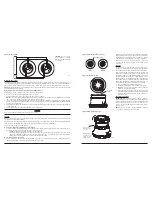
CAuTION: Do not loop wire
under terminal 1 or 2. Break
wire run to provide supervision
of connections.
H500-32-00
3
I56-1982-004R
Figure 4. Replacing the filter cover:
Figure 3. Test magnet position:
Figure 2. Rotary decade address switches:
C0162-00
A detector that fails any of these tests should be retested. If the
detector still fails any test, have its filter replaced (see instructions
below) and retested. Finally, if the detector continues to fail after
replacing the filter, it must be returned for repair or replacement.
When testing is complete, restore the system to normal opera-
tion and notify the proper authorities that the system is back
in operation.
TESTINg
The unique design of Filtrex eliminates the need for typical detector
cleaning. The only maintenance necessary is replacing the filter,
which is signaled by a trouble condition at the panel (see below).
Filtrex has been designed to maximize the amount of time before
maintenance is required. Filtrex utilizes a replaceable filter that
may become clogged over time. Filtrex detector monitors itself to
insure that the filter has not become clogged. Because environ-
mental conditions can vary significantly, the amount of time before
maintenance could vary significantly as well. To fully understand
maintenance requirements of Filtrex in its installed location, it is
recommended that the following test program be conducted.
1. Install the Filtrex detector in the desired location.
2. Connect the Filtrex detector to the fire alarm control panel.
3. Maintain a record for at least 90 days of any maintenance
performed on or required by Filtrex.
4. At the end of the test period, use the record to develop and
schedule maintenance. Filtrex should be serviced at regular
intervals to insure that the fire alarm system provides con-
tinuous protection.
REPlACINg THE FIlTER
IMPORTANT: When the filter becomes too clogged to draw ade-
quate air into Filtrex, power is automatically cut from the detector,
sending a trouble signal to the fire control panel. After 5 minutes,
power is restored to the detector for 72 hours. After 72 hours,
power is cut again and the detector will remain off-line until the
filter is replaced.
NOTE: The unit has two filters. The replaceable filter is inside the
cover. A permanent filter is mounted to the unit.
H500-32-00
2
I56-1982-004R
Figure 1. Wiring diagram:
WIRINg INSTRuCTIONS
All wiring must be installed in compliance with the National Electrical Code, applicable local codes, and any special requirements of
the Authority Having Jurisdiction. Proper wire gauges should be used. The installation wires should be color-coded to limit wiring mis-
takes and ease system troubleshooting. Improper connections will prevent a system from responding properly in the event of a fire.
NOTE: Although the TC844A1015 is an intelligent sensor, a separate pair of wires is required for power. This power must be provided
from a listed fire alarm power supply.
Remove power from the communication line before installing detectors.
All wiring must conform to applicable local codes, ordinances, and regulations.
1. Wire the sensor base per the wiring diagram, please see Figure 1.
2. Set the desired address on the sensor address switches, please see Figure 2.
NOTE: Some panels support extended addressing. In order to set the sensor above address 99 on compatible systems, carefully
remove the stop on the upper rotary switch with thumb as shown in Figure 2.
3. Insert 5-wire connector on mounting base into 5-pin connector on Filtrex unit. Install the detector into the sensor base. Push the
detector into the base while turning it clockwise to secure it in place. (Please see Figure 5 and INSTALLING FILTREX INTO BASE
on page 4 for specific directions.
4. After all detectors have been installed, turn on the detector power supply, then apply power to the control unit and activate the
communication line.
5. Test the detector(s) as described in the TESTING section of this manual.
CAUTION
Dust cover must be removed before the detector can sense smoke.
TESTINg
Before testing, notify the proper authorities that the system is undergoing maintenance, and will temporarily be out of service. Disable
the system to prevent unwanted alarms.
All detectors must be tested after installation and periodically thereafter. Testing methods must satisfy the Authority Having Jurisdiction
(AHJ). Detectors offer maximum performance when tested and maintained in compliance with NFPA 72.
The sensor can be tested in the following ways:
A. Functional: Magnet Test (P/N M02-04-01 or M02-09-00)
This detector can be functionally tested with a test magnet. The test magnet electronically simulates smoke in the sensing cham-
ber, testing the detector electronics and connections to the control panel.
1. Hold the test magnet in the magnet test area as shown in Figure 3.
2. The detector should alarm the panel. Two LEDs on the detector are controlled by the panel to indicate sensor status. Coded
signals, transmitted from the panel, can cause the LEDs to blink, latch on, or latch off. Refer to the control panel technical
documentation for detector LED status operation and expected delay to alarm.
B. Smoke Entry: Aerosol generator
Aerosol generators for smoke entry testing are available from a number of third party manufacturers (e.g., Gemini Scientific). Fol-
lowing the manufacturer’s instructions, apply aerosol until the panel alarms.
TEST MAGNET
MARKER
Cover is keyed to
fit into 4 matching
sized slots.
Alignment marks
are provided on the
cap and top of the
permanent filter.
LISTED COMPATIBLE CONTROL PANEL
AUX.
POWER
SUPPLY
+
+
–
–
AUX
+
AUX
–
AUX
+
AUX
–
2(–) 3(R
A) 4(S)
1(+)
1(+)
2(–) 3(R
A) 4(S
)
TENS
Breakaway Stop
ONES
9
10
11
12
13
14
15
8
7
6
5
4
3
2
1 0
9
8
7
6
5
4
3
2
1 0
C0845-00
C0191-00
C0121-00
C0190-00








